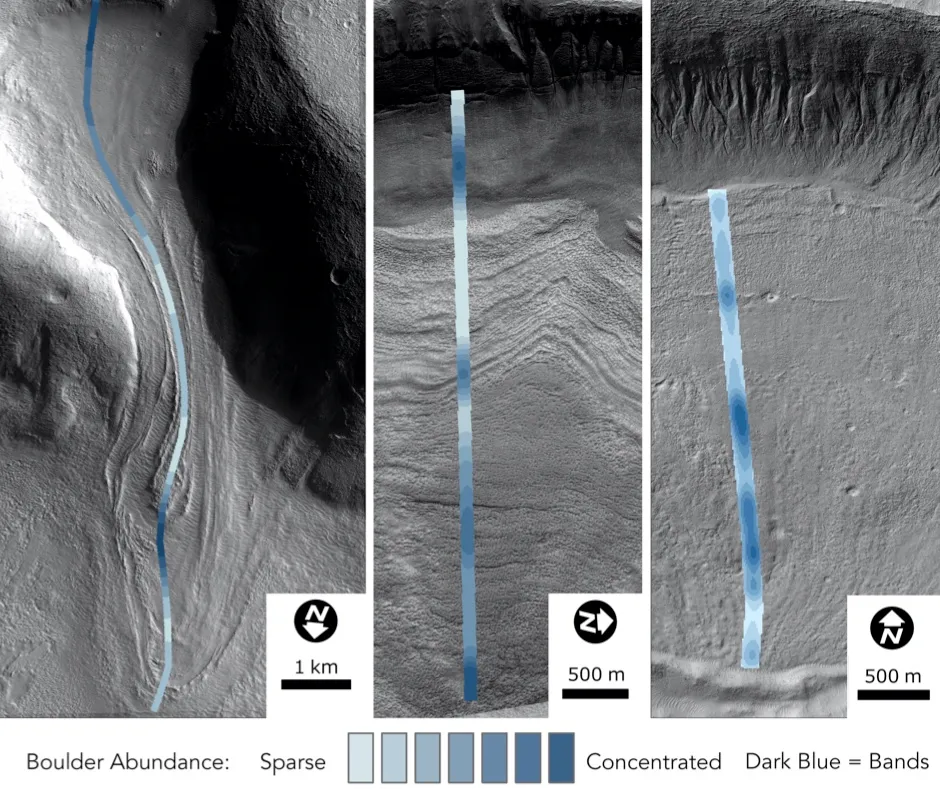Glaciers that have remained on the surface of Mars for hundreds of million years are revealing secrets of the planet’s unique geological past. By analysing the patterns and structures of rocks in 45 of the Red Planet’s glaciers, researchers at Colgate University, New York, have found that Mars underwent between 6 and 20 separate ice ages over the last 300 to 800 million years.
The team made the discovery after painstakingly poring over a series of high-resolution images collected by the Mars Reconnaissance Orbiter satellite and measuring the size of around 60,000 rocks.

If there was a single, long ice age event they would’ve expected to find a steady progression of larger to smaller rocks as they gradually eroded over time. However, they found that rocks of different sizes were distributed at random.
They also found that the rocks were distributed in clear bands of debris across the glaciers' surfaces, with each marking the limit of separate and distinct flows of ice indicating that each formed during a separate ice age.
Further examination of the glaciers could help scientists to figure out how Mars' climate changed over time - as well as what kind of rocks, gases, or even microbes might be trapped inside the ice.
Read more about Mars:
- Ancient megaflood hints at possibility of life on Mars
- Ingenuity: How the Mars helicopter will fly on another planet
- The next great search for life on Mars
“These glaciers are little time capsules, capturing snapshots of what was blowing around in the Martian atmosphere,” said Dr Joe Levy, a planetary geologist and assistant professor of geology at Colgate University.
“Now we know that we have access to hundreds of millions of years of Martian history without having to drill down deep through the crust -- we can just take a hike along the surface. If there are any biomarkers blowing around, those are going to be trapped in the ice too."
The team has now begun to map the rest of the glaciers on Mars' surface and hope to use an artificial intelligence system to count and analyse the rocks instead of human researchers to piece together a complete planetary history of Mars.
“There's a lot of work to be done figuring out the details of Martian climate history, including when and where it was warm enough and wet enough for there to be brines and liquid water,” said Dr Levy.
Reader Q&A: How did Mars lose its atmosphere?
Asked by: Aseer Awsaf
Mars today has a thin atmosphere: the volume of gases (mostly carbon dioxide) in its atmosphere is less than 1 per cent that of Earth’s. However, evidence from the surface of Mars indicates that the planet was once much warmer and wetter than today. This suggests that the Martian atmosphere must once have been much thicker, creating a strong greenhouse effect that trapped the Sun’s light.
Thanks to numerous missions to the Red Planet, we now know that in its early infancy, up until around four billion years ago, Mars had a strong magnetic field, created, just like Earth’s, by convection currents of molten metals in the planet’s core. But, unlike Earth, Mars cooled enough internally to switch off this mechanism, and the planet ended up with no global magnetic field. Without this magnetic field, the planet was less protected from the solar wind – the stream of energetic charged particles flowing from the Sun.
The solar wind stripped away most of the Martian atmosphere in only a few hundred million years after the planet lost its magnetic field. This process was quick because the Sun rotated much faster in its youth, which made the solar wind more energetic. The loss of a large fraction of its atmosphere to space was a major cause of Mars’s transition from a warm, wet climate to today’s cold, dry one.
In contrast, the fact that the Earth retained its magnetic field, which deflects the solar wind, and hence held on to its atmosphere, ultimately allowed life to develop here.
Read more: